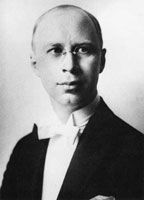Early Life and Musical Prodigy
Sergei Sergeyevich Prokofiev was born on April 23, 1891, in Sontsovka, Ukraine, then part of the Russian Empire. From an early age, Prokofiev displayed an exceptional aptitude for music. His mother, a talented pianist herself, recognized her son’s gift and became his first piano teacher.
By the age of five, Prokofiev had already composed his first piano piece. His precocious talent continued to flourish, and at nine, he wrote his first opera, “The Giant.” These early compositions foreshadowed the innovative and often unconventional style that would become his hallmark.
Formal Education and Early Career
In 1904, at the age of 13, Prokofiev entered the Saint Petersburg Conservatory. Here, he studied under renowned composers such as Nikolai Rimsky-Korsakov and Anatoly Lyadov. Despite his young age, Prokofiev quickly gained a reputation as a rebellious and forward-thinking student, often challenging the conservative tastes of his instructors.
During his time at the conservatory, Prokofiev composed several works that showcased his developing style, including his First Piano Concerto (1911) and his “Classical” Symphony (Symphony No. 1 in D major, 1917). The latter, in particular, demonstrated his ability to blend traditional forms with modern harmonies and rhythms.
Rise to International Fame
Following the Russian Revolution of 1917, Prokofiev left Russia for the United States, embarking on a period of international travel and acclaim. His opera “The Love for Three Oranges” (1921) premiered in Chicago and became an instant success, establishing him as a major figure in contemporary classical music.
During this period, Prokofiev also composed some of his most famous works, including:
Piano Concerto No. 3 in C major (1921)
This concerto is widely regarded as one of Prokofiev’s masterpieces, showcasing his virtuosic piano writing and innovative harmonic language.
Symphony No. 2 in D minor (1924)
This challenging and complex work reflects Prokofiev’s experimentation with dissonance and unconventional structures.
Return to Soviet Russia
In 1936, Prokofiev made the controversial decision to return to the Soviet Union permanently. This move would have a profound impact on his life and work, as he now had to navigate the complex political landscape of Stalinist Russia.
Despite the challenges, this period saw the creation of some of Prokofiev’s most beloved works:
This ballet, based on Shakespeare’s play, is one of Prokofiev’s most popular and enduring works. Its lush orchestration and memorable melodies have made it a staple of the ballet repertoire.
Peter and the Wolf (1936)
This symphonic fairy tale for children has become one of Prokofiev’s most recognizable compositions, introducing generations of young listeners to classical music.
Alexander Nevsky (1938)
Originally composed as a film score for Sergei Eisenstein’s epic historical film, this cantata showcases Prokofiev’s skill in writing dramatic, patriotic music.
War Years and Late Period
During World War II, Prokofiev continued to compose prolifically, creating works that reflected the turbulent times:
War and Peace (1941-1952)
This monumental opera, based on Tolstoy’s novel, is considered one of Prokofiev’s greatest achievements, blending intimate personal drama with grand historical events.
Symphony No. 5 in B-flat major (1944)
Composed at the height of World War II, this symphony is one of Prokofiev’s most popular orchestral works, celebrated for its optimism and grandeur.
In his later years, Prokofiev faced increasing pressure from Soviet authorities to conform to the ideals of Socialist Realism. Despite these constraints, he continued to produce innovative works, including:
Symphony No. 7 in C-sharp minor (1952)
His final symphony, completed just months before his death, is a poignant and introspective work that reflects on his life and career.
Musical Style and Innovations
Prokofiev’s musical style is characterized by several distinctive elements:
Neoclassicism
Prokofiev often drew inspiration from Classical-era forms and techniques, infusing them with modern harmonies and rhythms.
Lyricism
Despite his reputation for dissonance, Prokofiev was capable of writing deeply expressive and melodic music, particularly in his ballets and operas.
Rhythmic Vitality
His music often features driving, energetic rhythms and unexpected metric shifts.
Harmonic Innovation
Prokofiev expanded the boundaries of tonality, incorporating dissonant harmonies and unexpected modulations into his works.
Legacy and Influence
Sergei Prokofiev passed away on March 5, 1953, ironically on the same day as Joseph Stalin. His death marked the end of an era in Russian music, but his influence continues to resonate throughout the classical music world.
Prokofiev’s impact on 20th-century music is immeasurable. His innovative approach to harmony, rhythm, and form influenced countless composers who followed him. His ability to blend traditional elements with modern techniques created a unique musical language that remains fresh and exciting to this day.
Many of Prokofiev’s works have become staples of the classical repertoire, performed regularly by orchestras, ballet companies, and opera houses around the world. His music for children, particularly “Peter and the Wolf,” has introduced generations of young listeners to the joys of classical music.
Conclusion
Sergei Prokofiev’s life and work embody the spirit of innovation and artistic integrity in the face of political and social upheaval. From his early days as a child prodigy to his final years as a Soviet composer, Prokofiev remained committed to pushing the boundaries of classical music.
His vast and varied oeuvre, spanning operas, ballets, symphonies, concertos, and chamber works, demonstrates his versatility as a composer and his ability to excel in multiple genres. Whether writing for children or tackling complex philosophical themes, Prokofiev’s music always retained its distinctive voice – at once modern and timeless, challenging and accessible.
As we continue to perform, study, and enjoy Prokofiev’s music in the 21st century, we are reminded of the power of artistic vision to transcend political boundaries and speak to the human experience. Sergei Prokofiev’s legacy as one of the greatest composers of the 20th century is secure, his music continuing to inspire, provoke, and move audiences around the world.

